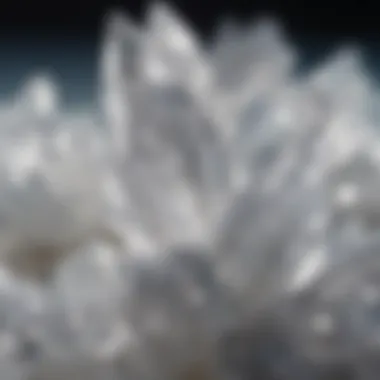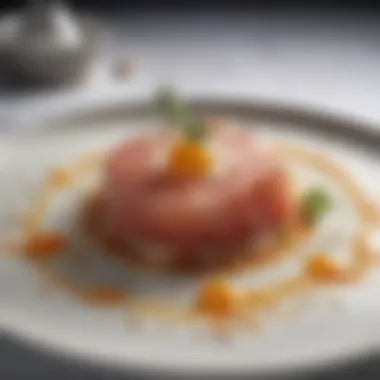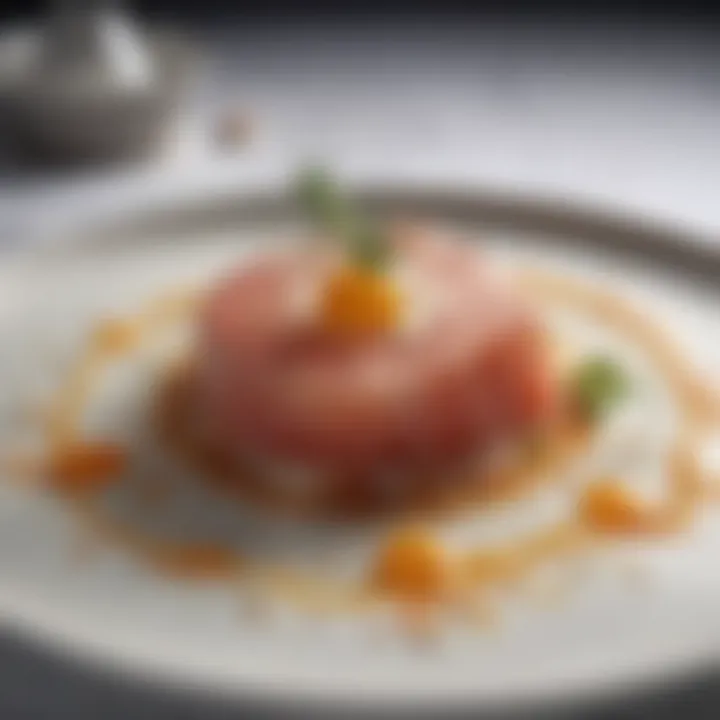The Essence of Fleur de Sel: An In-Depth Exploration


Intro
Fleur de sel is much more than a simple culinary salt. It embodies a rich history and complexity that has captivated chefs and food lovers alike. Originating from the coastal regions of France, this salt has a distinct texture and flavor that elevate dishes in unique ways. Its production involves labor-intensive methods that respect traditional practices, making it a cherished ingredient in fine dining.
Historically, fleur de sel was harvested by hand, creating a link between nature and culinary artistry. This method ensures that the delicate flakes retain the purity of the sea, which is part of its unique appeal. In today's gastronomic world, it stands as a symbol of quality and sophistication.
This article will explore various aspects of fleur de sel. From its origins and production methods to its culinary applications and health benefits, we aim to create a comprehensive guide. Readers will gain insights into how this special salt compares with other salts and its role in modern cooking.
Whether you are a chef seeking to enhance your dishes or a food enthusiast wanting to learn more about this exquisite ingredient, understanding the essence of fleur de sel could prove valuable.
Prolusion to Fleur de Sel
Fleur de Sel is often regarded as the pinnacle of sea salts, celebrated for its delicate flavor and unique texture. This introduction sets the stage for a deeper understanding of fleur de sel's significance in culinary practices. As we explore this topic, it is crucial to appreciate how the specific elements of fleur de sel contribute to its widespread adoration among chefs and food enthusiasts alike.
Understanding Fleur de Sel
Fleur de Sel, which translates to "flower of salt," is harvested from the surface of salt ponds, typically in coastal regions. Unlike regular sea salt, which undergoes extensive processing, fleur de sel is collected through a manual method. This meticulous process ensures that only the purest crystals, untarnished by harsh handling, are selected. The result is a salt that retains minerals and trace elements, offering not just seasoning but a complex flavor profile.
Many chefs prefer using fleur de sel as a finishing salt due to its light, flaky texture, which adds a burst of flavor without overpowering the dish. The salt's ability to dissolve quickly means it enhances the palatability of both sweet and savory foods.
Characteristics of Fleur de Sel
Fleur de Sel possesses distinctive traits that make it stand out from other salts. Its crystals are larger and more irregular compared to table salt, presenting a visually appealing contrast on plated dishes. The color varies from off-white to light gray, influenced by the minerals present in the harvesting waters.
Moreover, fleur de sel is known for its subtle briny taste, which can enhance the flavors in a diverse range of cuisines. These characteristics allow it to be used beyond basic seasoning; it can elevate the flavor profile of high-end dishes and simple meals alike.
"The delicate nature of fleur de sel makes it more than just a seasoning; it is an artisanal product that connects chefs with the sea and the craftsmanship of its harvest."
Fleur de sel's unique qualities are also linked to its geographical origins. Different regions produce salt with varying flavors based on local water and weather conditions. This geographical significance adds another layer to the appreciation of this exceptional sea salt.
Historical Context
Understanding the historical context of fleur de sel enriches our appreciation for this culinary treasure. Through its history, we can see how it has evolved from a simple agricultural product to a sought-after gourmet ingredient. This section explores the origins and the evolution of its usage, highlighting its significance in culinary arts.
Origins of Fleur de Sel
Fleur de sel, often referred to as the "flower of salt," has its origins primarily in the coastal regions of France, particularly in areas like Guérande and Camargue. It is a natural sea salt harvested by hand from shallow salt pans. The process involves collecting the delicate, flaky crystals that form on the surface of seawater as it evaporates under the sun. This method dates back to antiquity and emphasizes the traditional craftsmanship involved in its production.
For centuries, this type of salt was used locally and had humble beginnings. Fishermen and farmers utilized it to preserve fish and enhance the flavor of their meals. The meticulous harvesting process limited its availability, which created a stronger connection to the land and ocean. As culinary practices evolved, so too did the recognition of fleur de sel.
The salt was long considered a part of the everyday life of those living near France's coastal areas. Yet, its gradual rise into haute cuisine reflects broader trends in cooking, where premium ingredients became synonymous with culinary innovation.
Evolution of Usage
The evolution of fleur de sel is indicative of changing culinary landscapes and society's relationship to food. Initially used mainly for preservation, its transformative potential for flavor became more widely recognized by chefs and gastronomes. Over time, chefs began to experiment more with fleur de sel, appreciating not just its taste, but also its texture and visual appeal when presented on dishes.
In contemporary cooking, fleur de sel has found its place as a finishing salt. It adds a delicate crunch and bursts of salinity that enhance the overall experience of a dish. Its usage varies widely, from being a garnish on meats and vegetables to elevating desserts.
"Fleur de sel is more than just salt; it is a touch of history and craft in every grain."
As global cuisines have become more interconnected, fleur de sel has also transcended regional boundaries. It is now embraced by chefs and home cooks alike worldwide. This evolution highlights its importance not just as a seasoning, but as a key player in modern gastronomy. The journey of fleur de sel reflects how our collective tastes and appreciation for high-quality ingredients have evolved over centuries.
Production Process of Fleur de Sel


The production of fleur de sel is a delicate and meticulous process that showcases the intricate relationship between nature and culinary art. Understanding the production techniques that yield this esteemed salt not only illuminates its exquisite flavor but also enhances appreciation for its culinary value. The unique characteristics of fleur de sel arise from specific harvesting methods and geographical conditions, which are crucial in establishing its identity.
Harvesting Techniques
Harvesting fleur de sel requires skilled hands, as it is not simply collected like common table salt. Typically, it is cultivated in coastal salt marshes, particularly in regions like Brittany, France. The process begins with the evaporation of seawater in shallow ponds, known as "marais salants." As the sun heats the water, the concentration of salt increases, and conditions for harvesting become optimal.
The delicate crust of fleur de sel forms on the water’s surface, a phenomenon dependent on specific weather and environmental factors. Harvesters use a tool called a "lousse" to carefully skim the salt from the surface. This requires not only precision but also an understanding of nature, as the timing and conditions contribute significantly to the quality and flavor of the final product.
Some key aspects of harvesting include:
- Timing: Harvesting occurs primarily during warm, sunny days when conditions are right for the salt crust to develop.
- Technique: The process must be done gently to avoid disturbing the salt and to ensure only the finest crystals are collected.
- Seasonality: The best fleur de sel is often gathered in summer months, when evaporation rates are highest.
Geographical Significance
The geographical location of salt marshes plays a vital role in the distinctive qualities of fleur de sel. It is predominantly harvested in specific regions that possess the ideal climate and environmental conditions conducive to its formation. For instance, the salt marshes of Île de Ré and Guérande in France are known for producing some of the best fleur de sel.
Several geographical factors contribute to its uniqueness:
- Climate: The local climate must include strong sunshine and moderate winds, both of which aid in the evaporation process.
- Biodiversity: The surrounding flora and fauna can impact the flavor of salt. The presence of specific plants and microorganisms can impart subtle variations in taste.
- Water Quality: Clean, unpolluted seawater is critical. The purity of the water from which fleur de sel is harvested enhances its flavor profile, making it richer and more complex.
Comparison with Other Salts
Understanding how fleur de sel stacks against other types of salt is crucial for appreciating its unique qualities and culinary versatility. Each type of salt is produced differently, impacting its flavor, texture, and usage in cooking. This section aims to provide a clear comparison between fleur de sel, sea salt, and table salt, illustrating why fleur de sel holds a distinctive place in culinary arts.
Fleur de Sel vs. Sea Salt
Fleur de sel and sea salt share a common source—ocean water—but their harvesting and processing differ significantly. Fleur de sel is often regarded as the crème de la crème of sea salts. It is collected from the surface of salt ponds, forming a delicate crust that floats atop seawater during evaporation. Sea salt, on the other hand, is typically harvested from the bottom of the evaporation ponds, resulting in a coarser texture and a different flavor profile.
• Texture: Fleur de sel consists of fragile crystals, which provide a crunch when used as a finishing salt. Sea salt grains are larger and can vary from fine to coarse depending on the production method.
• Flavor: Fleur de sel has subtle traces of brininess and minerals that enhance dishes, while sea salt’s flavor can be stronger and saltier, depending on its source and production process.
• Use: Fleur de sel is primarily used as a finishing salt, perfect for enhancing the flavor of dishes just before serving. Sea salt is versatile and can be used in cooking and baking.
Fleur de sel’s production process captures specific minerals that might not be present in regular sea salt, making it sought after in gourmet cooking.
"Fleur de sel is not just a seasoning; it is an experience for discerning palates."
Fleur de Sel vs. Table Salt
Table salt is a ubiquitous seasoning that contrasts sharply with fleur de sel in several key aspects:
• Processing: Table salt undergoes extensive refining that removes natural minerals. This results in a stark white appearance and a more uniform texture. In contrast, fleur de sel retains some of the natural minerals and moisture, giving it a more complex composition. • Additives: Most table salt contains additives like anti-caking agents and iodine, which are not found in pure fleur de sel. These additives can alter the taste and mouthfeel of the salt, while fleur de sel remains pure and untainted. • Flavor: The flavor of table salt is straightforward and somewhat one-dimensional, which contrasts with the layered taste profiles of fleur de sel that come from its mineral content. • Culinary Use: Table salt is generally used during cooking for seasoning but lacks the textural and flavor complexity needed for finishing dishes. Fleur de sel excels in its role as a delicate finishing touch, enhancing the aroma and flavor right before serving.
Culinary Applications
Culinary applications of fleur de sel are vital to understanding its value in the kitchen. This special salt enhances flavor in various dishes and adds a unique texture. It provides chefs with a versatile option that can elevate meals. Fleur de sel is not just a seasoning; it is a finishing salt that can change the way you experience the taste of food. This section explores how fleur de sel can be used effectively in cooking and baking, its pairing properties, and its trendy use in gourmet settings.
Use in Gourmet Cooking
Fleur de sel is often classified as a luxury ingredient, particularly in gourmet cooking. It is harvested in such a way that preserves its delicate flavor and texture. Chefs appreciate its flaky form, which contrasts with denser salts. When used as a finishing touch, it imparts a light crunch while melting into the dish, enhancing the overall flavor profile. It can be found sprinkled over meats, vegetables, and seafood, allowing each bite to reveal bursts of saltiness.
One reason why chefs prefer fleur de sel is its unique mineral content and the subtle sweetness it adds. This creates a balance in dishes, particularly in rich or fatty foods like duck or pork. Because it is harvested by hand, the quality is generally high, and impurities are less common compared to industrial salts. Using fleur de sel can make even the simplest dishes feel special and well thought out.
Pairing with Different Dishes
Pairing fleur de sel with various dishes requires a keen understanding of flavors. It complements a wide range of items, from fresh salads to baked goods. In seafood preparations, it enhances the natural flavors of fish, making the salt ideal for grilled or charred presentations. For vegetable dishes, using a sprinkle of fleur de sel can heighten their sweetness, especially with heirloom tomatoes or grilled asparagus.
Desserts also benefit from fleur de sel. Consider its use atop dark chocolate desserts or caramel candies. The contrast of sweet and salty creates an inviting experience. It is essential to pair fleur de sel carefully, ensuring it does not overpower other flavors but rather enhances them. Here are some ideal pairings:


- Grilled meats, such as beef or lamb
- Fresh salads with citrus dressings
- Heirloom tomato dishes
- Dark chocolate desserts
- Cured fish like salmon or mackerel
This careful curation of ingredients can lead to extraordinary dining experiences.
Incorporating Fleur de Sel in Baking
Incorporating fleur de sel into baking provides a unique approach to flavor enhancement. It can be included in doughs or sprinkled on top of baked goods before serving. The salt contrasts beautifully with sweetness in cookies or pastries. When baking bread, adding fleur de sel to the dough can encourage enhanced crust properties and flavor complexity.
It is crucial to consider the right quantity while baking. Too much salt can alter the texture or rise of the baked good. Therefore, it is recommended to use fleur de sel sparingly, focusing on its finishing uses rather than mixing it into every layer. The effect should be a rounded flavor, not a salty punch.
"Fleur de sel dramatically improves the character of baked goods when applied properly, showcasing the chef's skill and attention to detail."
By using fleur de sel in various culinary applications, chefs and home cooks alike can create dishes that are not only delicious but also visually appealing. The applications are many, showing that fleur de sel is a critical component in the culinary world.
Health Benefits of Fleur de Sel
Fleur de Sel does not just serve as a flavorful seasoning; it also carries potential health benefits that attract many food lovers. Understanding how it aligns with one's dietary needs and wellness goals can enhance its appeal. While many might think of salt primarily as a flavor enhancer, its nutritional profile is vital to consider.
Nutritional Profile
Fleur de Sel differs significantly from regular table salt and even sea salt in its composition. It is composed primarily of sodium chloride, but it also contains trace minerals. These include potassium, magnesium, and calcium, which contribute to its unique flavor profile and texture.
Typically, a teaspoon of Fleur de Sel contains about 590 mg of sodium, along with small amounts of the trace elements mentioned. The presence of these minerals suggests that fleur de sel offers more than just sodium. However, the actual nutritional benefits depend on the quantity consumed.
- Sodium: Essential for bodily functions but should be limited to prevent hypertension.
- Magnesium: Supports muscle and nerve function.
- Calcium: Important for bone health.
Potential Health Benefits
In moderation, the consumption of Fleur de Sel may offer several potential benefits. Eating salt is often frowned upon due to high sodium levels, but Fleur de Sel could provide a slightly different experience.
- Hydration: Proper salt intake helps maintain fluid balance in the body, which is crucial for hydration.
- Taste Enhancement with Less Salt: Fleur de Sel's unique texture and flavor may allow for less quantity to be used. This can enable individuals to enjoy meals seasoned adequately without overindulging in sodium.
- Mineral Contribution: The trace minerals in Fleur de Sel could supplement a person’s diet, supporting various bodily functions. However, these benefits are best seen when Fleur de Sel is used as part of a balanced diet rather than exceeding recommended sodium intake levels.
The key takeaway is that Fleur de Sel, while a flavorful option, should be used with caution in sodium-restricted diets.
Sourcing and Purchasing Fleur de Sel
Understanding where to source and how to purchase fleur de sel is significant for both culinary enthusiasts and professional chefs. This topic allows us to explore the distinctions in quality and authenticity. Given that fleur de sel is not just a common salt but a gourmet product, discerning buyers need to know what specifics to consider when acquiring it.
The quality of fleur de sel varies considerably. Several factors influence this, including the source of the salt, the harvesting method, and the processing involved. Furthermore, not all fleur de sel is created equal; each region contributes its own unique mineral content and texture. Therefore, the purchasing decision should not be taken lightly, as the salt's characteristics can greatly enhance or detract from culinary applications.
Identifying Quality Fleur de Sel
When searching for quality fleur de sel, certain key indicators should be kept in mind. First, look for fleur de sel that has a fine, flaky texture. This characteristic is essential because it leads to an optimal melt on the palate. The color should range from white to light grey, depending on the mineral content. A product that appears too uniform or processed could indicate lower quality.
"High-quality fleur de sel contains natural minerals and is harvested traditionally, ensuring its unique flavor profile and texture."
Additionally, consider the label. Authentic fleur de sel often specifies the region of harvest. For example, fleur de sel de Guérande from France is particularly sought after due to its unique attributes. Be cautious of overly generic labels that simply state 'sea salt' or 'fleur de sel' without any indication of provenance. Reading reviews and testimonials can also provide insights into product quality.
Where to Buy Fleur de Sel
Purchasing fleur de sel can be done through various channels depending on convenience and preference. Specialty gourmet shops often carry high-quality varieties. These shops usually maintain strict quality control and often represent artisanal producers.
Online platforms also offer a broad selection. Websites like Amazon feature multiple brands. However, understanding which vendor is reputable is crucial. Verified customer reviews can be a useful resource. Always buy from sellers who provide detailed descriptions, including origin and harvesting practices.


Farmers' markets and local food fairs can also be excellent places to find authentic fleur de sel. Engaging directly with producers allows the buyer insight into the harvesting process, enhancing the appreciation for this gourmet salt.
In summary, sourcing and purchasing fleur de sel requires careful consideration. Quality, origin, and purchasing channel all play essential roles in ensuring that the product selected meets the standards expected for gourmet cooking and enhances culinary creations.
Fleur de Sel in Culinary Trends
The role of fleur de sel in current culinary trends is significant, reflecting a broader movement towards artisanal and high-quality ingredients in gastronomy. This salt is not just a seasoning; it's a statement of care and attention to detail in cooking. Chefs and home cooks alike are increasingly drawn to its unique flavor profile and texture, which contribute both to the taste and appearance of dishes.
Current Trends in Salt Usage
Salt has always been an essential ingredient, but recent trends have elevated its role in culinary art. Chefs are moving beyond traditional table salt and exploring the diverse world of salts, including fleur de sel. Several factors contribute to this trend:
- Flavor Complexity: Fleur de sel provides a subtle yet distinct taste that enhances the flavor of food. Its flaky texture allows it to dissolve quickly, releasing its flavor without overpowering other ingredients.
- Artisan Appeal: The production of fleur de sel is often artisanal, involving careful harvesting methods. This creates a narrative that resonates with consumers interested in sustainability and provenance.
- Visual Presentation: Its delicate flakes can add visual appeal to dishes. Sprinkling fleur de sel over a finished plate not only enhances flavor but also creates a striking contrast against the food.
This shift towards artisanal salts encourages chefs to experiment and incorporate them into various culinary applications.
Fleur de Sel in Modern Gastronomy
In modern gastronomy, the use of fleur de sel is more than just a trend. It is a vital component of many contemporary cooking philosophies. Some aspects include:
- Fine Dining: High-end restaurants often showcase fleur de sel as a finishing touch. This elevates dishes, adding layers of flavor and textural contrast. It signals a commitment to quality ingredients, appealing to discerning diners.
- Home Cooking: As home chefs become more adventurous, fleur de sel is gaining popularity in everyday cooking. Recipes now frequently suggest using fleur de sel to complement meats, vegetables, and even desserts. Its versatility allows it to shine in diverse culinary settings.
- Culinary Workshops: Many cooking classes now include sessions on salt usage, emphasizing the importance of fleur de sel. Workshops aim to educate participants on how to properly utilize fleur de sel to enhance flavors and improve results in various recipes.
The rise of fleur de sel in culinary trends reflects a deep connection between ingredient quality and cooking philosophy. Chefs are increasingly looking for ways to translate this into their dishes.
Overall, the fascination with fleur de sel is indicative of a greater appreciation for flavor nuance and ingredient integrity in the culinary landscape. Its integration into both professional and home kitchens signifies a collective movement towards celebrating quality and craftsmanship in food preparation.
Cultural Significance
Fleur de sel holds a significant place in various cultures around the world. It is not just a seasoning but a symbol of culinary artistry and regional identity. From the coastal regions of France to gourmet kitchens globally, this salt is revered for its unique texture and flavor. The cultural importance of fleur de sel lies in its role as a key ingredient that elevates dishes, adds depth to recipes, and creates a connection between people and their culinary heritage.
Fleur de Sel in Global Cuisines
Global cuisines have embraced fleur de sel in ways that reflect their regional culinary practices. In French cuisine, it is often used as a finishing salt, sparking a contrast in flavors and textures. Chefs sprinkle fleur de sel on fresh seafood, grilled meats, or vegetables, allowing the salt to enhance the natural flavors without overpowering them. This practice highlights the importance of quality ingredients and showcases the chef’s skill in balancing flavors.
In other culinary traditions, fleur de sel finds its way into desserts. Pastry chefs in various countries use this salt to contrast sweetness in caramel, chocolates, or even fruit dishes. The addition of fleur de sel in dessert emphasizes the sophisticated flavor profiles that emerge from sweet and salty combinations, appealing to a diverse palate.
Regional Variations
Different regions produce unique varieties of fleur de sel. These regional variations come from the specific environments where the salt is harvested. For instance, fleur de sel from Guérande, France, has a distinctive gray hue due to the presence of clay in the salt marshes. Its moist texture and rich mineral content set it apart from other salts.
In contrast, the fleur de sel produced in other regions, like the Algarve in Portugal, can be lighter and flakier, with a different flavor profile. Such differences often reflect local harvesting techniques and environmental factors, making each type of fleur de sel special in its own right. Understanding these regional variations can deepen appreciation for this salt and its role in local traditions.
"Fleur de sel is not merely an ingredient; it is an expression of the land and culture from which it comes."
The cultural significance of fleur de sel extends beyond its culinary uses. It embodies a philosophy of slow food and conscious cooking that emphasizes quality over quantity. Using fleur de sel encourages mindfulness in the kitchen, promoting a deeper connection to food and its origins. This connection elevates the cooking experience and enhances the enjoyment of the meal, making fleur de sel a truly essential ingredient in global cuisines.
The End
The conclusion of this exploration into fleur de sel serves as an important synthesis of the various elements discussed throughout the article. This section provides a final reflection on why fleur de sel is not just a commodity, but a significant player in the culinary world. Whether it is examined through its unique characteristics, historical background, or culinary applications, the importance of this special salt continues to resonate with chefs and home cooks alike.
Summarizing the Importance of Fleur de Sel
Fleur de sel is more than a seasoning; it embodies a cultural heritage and offers unique sensory dimensions that differentiate it from other salts. Its delicate crystals are produced under specific climatic conditions, ensuring a distinct taste and texture. While many salts can enhance flavor, fleur de sel adds a subtle crunch and a complex flavor profile that elevates dishes.
The historical significance of fleur de sel also adds depth to its character. Originating from specific regions, its production methods reflect a commitment to craftsmanship that has been passed down through generations. This salt is often hand-harvested, which contributes not only to its quality but also to its scarcity. As a result, it carries both prestige and practicality, making it a preferred choice among chefs seeking to enhance their culinary creations.
Future Perspectives on Fleur de Sel
Looking ahead, fleur de sel is likely to maintain its presence in the culinary landscape, influenced by ongoing food trends and the ever-evolving palate of consumers. As people continue to seek out natural and artisanal ingredients, fleur de sel will bridge the gap between tradition and modern gastronomy. The shift towards sustainability in sourcing will also play a key role in determining how fleur de sel is produced and marketed.
Moreover, the increasing interest in global cuisines will allow fleur de sel to find its way into various culinary practices beyond its traditional roots. It has the potential to inspire creative applications across different culinary styles and fusion dishes.







